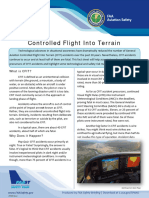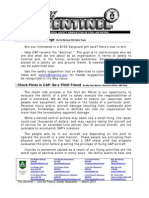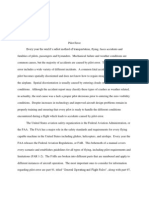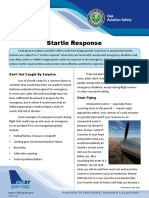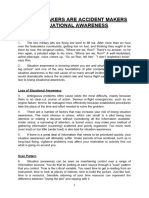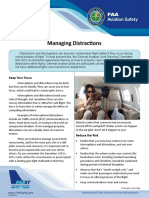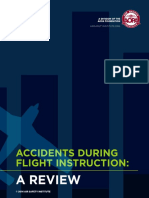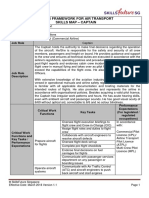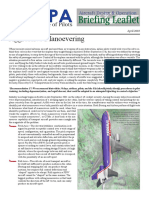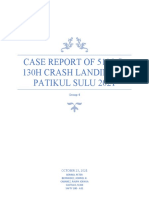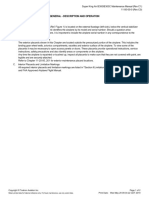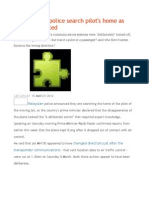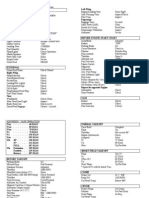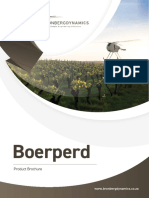0 ratings0% found this document useful (0 votes)
51 viewsFly The Aircraft First
Fly The Aircraft First
Uploaded by
zobiThe document discusses the importance of maintaining aircraft control and prioritizing flying the aircraft above all other tasks. It emphasizes that pilots should always "aviate, navigate, communicate," with aviating as the top priority. The crash of Eastern Airlines Flight 401 is used as an example of a crew that became too distracted by a mechanical issue and failed to maintain control of the aircraft. The document encourages pilots to minimize distractions and stay ahead of the aircraft in order to have more time to assess any issues that arise during flight.
Copyright:
© All Rights Reserved
Available Formats
Download as PDF, TXT or read online from Scribd
Fly The Aircraft First
Fly The Aircraft First
Uploaded by
zobi0 ratings0% found this document useful (0 votes)
51 views2 pagesThe document discusses the importance of maintaining aircraft control and prioritizing flying the aircraft above all other tasks. It emphasizes that pilots should always "aviate, navigate, communicate," with aviating as the top priority. The crash of Eastern Airlines Flight 401 is used as an example of a crew that became too distracted by a mechanical issue and failed to maintain control of the aircraft. The document encourages pilots to minimize distractions and stay ahead of the aircraft in order to have more time to assess any issues that arise during flight.
Original Title
Fly the Aircraft First
Copyright
© © All Rights Reserved
Available Formats
PDF, TXT or read online from Scribd
Share this document
Did you find this document useful?
Is this content inappropriate?
The document discusses the importance of maintaining aircraft control and prioritizing flying the aircraft above all other tasks. It emphasizes that pilots should always "aviate, navigate, communicate," with aviating as the top priority. The crash of Eastern Airlines Flight 401 is used as an example of a crew that became too distracted by a mechanical issue and failed to maintain control of the aircraft. The document encourages pilots to minimize distractions and stay ahead of the aircraft in order to have more time to assess any issues that arise during flight.
Copyright:
© All Rights Reserved
Available Formats
Download as PDF, TXT or read online from Scribd
Download as pdf or txt
0 ratings0% found this document useful (0 votes)
51 views2 pagesFly The Aircraft First
Fly The Aircraft First
Uploaded by
zobiThe document discusses the importance of maintaining aircraft control and prioritizing flying the aircraft above all other tasks. It emphasizes that pilots should always "aviate, navigate, communicate," with aviating as the top priority. The crash of Eastern Airlines Flight 401 is used as an example of a crew that became too distracted by a mechanical issue and failed to maintain control of the aircraft. The document encourages pilots to minimize distractions and stay ahead of the aircraft in order to have more time to assess any issues that arise during flight.
Copyright:
© All Rights Reserved
Available Formats
Download as PDF, TXT or read online from Scribd
Download as pdf or txt
You are on page 1of 2
General Aviation FAA
Joint Steering Committee Aviation Safety
Safety Enhancement Topic
January 2015
Fly the Aircraft First
NTSB accident data suggest that pilots, while distracted by less essential taskings, have lost control of
their aircraft and crashed. In light of this pilots are reminded to maintain aircraft control at all times. This
may mean a delay in responding to ATC communications and passenger requests, or not responding at all
unless positive aircraft control can be maintained throughout. In other words, Fly the Aircraft First!
It’s as Easy as A-N-C A famous example of failure to follow the
From the earliest days of flight training, established aviation priorities is the crash of Eastern
pilots are taught an important set of priorities that Airlines Flight 401. In December 1972, the crew of a
should follow them through their entire flying Lockheed L-1011 TriStar became focused on the
career: Aviate, Navigate, and Communicate. malfunction of a landing gear position indicator light
The top priority — always — is to aviate. for the nose gear. The plane subsequently
That means fly the airplane by using the flight descended into the Everglades northwest of Miami,
controls and flight instruments to direct the killing 101 of the 176 people on board.
airplane’s attitude, airspeed, and altitude. The
Despite all the advantages the crew in this
instruments directly in front of the pilot provide
situation had
important information on how well the pilot is
(there were four
doing with respect to basic aircraft control. Starting
professional
from the top left and moving clockwise, the pilot
aviators in the
gets information on airspeed, attitude with relation
cockpit), the
to the horizon, altitude, vertical speed and rate,
outcome was still
magnetic heading, and turns and coordination (i.e.,
disastrous
is the fuselage aligned with the direction of flight).
because the entire
Rounding out those top priorities are
crew became
figuring out where you are and where you’re going
engrossed in the
(Navigate), and, as appropriate, talking to ATC or
mechanical issue
someone outside the airplane (Communicate). It
and no one was
seems simple to follow, but it’s easy to forget when
left to keep the
you get busy or distracted in the cockpit.
airplane in the air.
While there were
other contributing factors in this accident, the most
critical was failure to aviate.
Continued on Next Page
www.FAASafety.gov Produced by FAA Safety Briefing | Download at 1.usa.gov/SPANS
Disconnect from Distractions authority and declare an emergency. It’s always
As we can see from the Eastern Airlines better to explain your actions from a safe place on
example, distractions can be deadly in an emergency the ground than to have the NTSB speculating about
situation and can rob your focus from more critical them in a report you aren’t around to read.
items or tasks. Resources
Do everything you can to minimize
distractions from every source. If you have NTSB Accident Report for Eastern Flight 401
passengers aboard, explain sterile cockpit practices http://libraryonline.erau.edu/online-full-text/ntsb/
during the preflight briefing and again when you aircraft-accident-reports/AAR73-14.pdf
conduct the pre-landing briefing. Even if you are FAA Airplane Flying Handbook, Chapter 16,
alone, it is a good idea to self-brief. Verbally Emergency Procedures
reviewing sterile cockpit procedures can help you
www.faa.gov/regulations_policies/handbooks_manuals/
establish the focused, no-nonsense mindset you
aircraft/airplane_handbook/media/faa-h-8083-3a-
need for critical phases of flight. Also consider giving 7of7.pdf
your passengers a job to do such as scanning for
traffic or calling out altitudes. FAA Risk Management Handbook, Chapter 6,
Staying ahead of the airplane is another good Single Pilot Resource Management
way to stave off distractions. That way, if something www.faa.gov/regulations_policies/handbooks_manuals/
comes up during a flight, you’ll have more time to aviation/risk_management_handbook/media/
assess its impact on safety and determine an rmh_ch06.pdf
appropriate course of action. Aviate—Navigate—Communicate: FAA Safety.gov
Online Course
It’s All a Matter of Priority
www.faasafety.gov/gslac/ALC/course_content.aspx?
Part of the PIC’s responsibility for preflight cID=40
planning and conduct of the flight is to avoid “Setting Priorities,” March/April 2013 FAA Safety
situations that require a choice between breaking Briefing
regulatory barriers (e.g., Class B airspace) and
www.faa.gov/news/safety_briefing/2013/media/
breaching physical barriers (e.g., the ground or an
MarApr2013.pdf
obstacle such as a building). But when such a choice
must be made, it’s important to evaluate the risk,
make the best choice for safety of flight, and
remember the mantra of Aviate, Navigate,
Communicate.
A final thought: if you think you might be in
an emergency, then you probably are. Use the PIC’s
www.FAASafety.gov Produced by FAA Safety Briefing | Download at 1.usa.gov/SPANS
You might also like
- Flight Safety - MultitaskingDocument6 pagesFlight Safety - MultitaskingGiulio Lo BelloNo ratings yet
- Training Fact Sheet - Controlled Flight Into Terrain: CFIT - How Does It Happen?Document2 pagesTraining Fact Sheet - Controlled Flight Into Terrain: CFIT - How Does It Happen?ja2ja1No ratings yet
- A Pilot's Accident Review: An in-depth look at high-profile accidents that shaped aviation rules and proceduresFrom EverandA Pilot's Accident Review: An in-depth look at high-profile accidents that shaped aviation rules and proceduresRating: 5 out of 5 stars5/5 (1)
- Argumentation Final Essay - Alfredo JaimeDocument7 pagesArgumentation Final Essay - Alfredo JaimeAlfredo R JaimeNo ratings yet
- Single Pilot Operations Position Paper ALPADocument32 pagesSingle Pilot Operations Position Paper ALPAAviation LibraryNo ratings yet
- CFIT REV 0 (Downloaded 2021-Jan-15-18 04)Document2 pagesCFIT REV 0 (Downloaded 2021-Jan-15-18 04)dani.dekovicNo ratings yet
- Bayflight Multi Crew CoDocument11 pagesBayflight Multi Crew CocharlieyankeenzNo ratings yet
- The Problem': AutomationDocument5 pagesThe Problem': Automationalibaba1888No ratings yet
- Sentinel Name Change: Safety@capnhq - GovDocument8 pagesSentinel Name Change: Safety@capnhq - Govcapok113No ratings yet
- This Page Intentionally Left BlankDocument7 pagesThis Page Intentionally Left BlankpremNo ratings yet
- HFH ch14Document18 pagesHFH ch14Zarahima IseaNo ratings yet
- Title Goes Here Subtitle HereDocument9 pagesTitle Goes Here Subtitle Hereaesthetic skyNo ratings yet
- Phil Mccain Ap English 12 5 Hour Mr. TothDocument6 pagesPhil Mccain Ap English 12 5 Hour Mr. TothPhil McCainNo ratings yet
- Success of CRMDocument7 pagesSuccess of CRMSayandeep karNo ratings yet
- AC - 120-48A - Communication and Coordination Between Flightcrew Members and Flight AttendantsDocument25 pagesAC - 120-48A - Communication and Coordination Between Flightcrew Members and Flight Attendantssc234983No ratings yet
- Startle ResponseDocument2 pagesStartle ResponseelaboratesolverNo ratings yet
- Eol 3Document3 pagesEol 3api-632633923No ratings yet
- PHAK ch1.2 - SummerizeDocument7 pagesPHAK ch1.2 - Summerizestellasong1117No ratings yet
- Professional Pilot: Proven Tactics and PIC StrategiesFrom EverandProfessional Pilot: Proven Tactics and PIC StrategiesRating: 5 out of 5 stars5/5 (1)
- Inadvertent Instrument Meteorological Conditions (IIMC)Document24 pagesInadvertent Instrument Meteorological Conditions (IIMC)Faisal JavedNo ratings yet
- 2019 Trial Trial Trial Home Study Guide Avss May 2019Document12 pages2019 Trial Trial Trial Home Study Guide Avss May 2019najwaNo ratings yet
- 001e Ramp SafetyDocument14 pages001e Ramp SafetyAslamNo ratings yet
- Ga - Weather - Decision - Making II PDFDocument37 pagesGa - Weather - Decision - Making II PDFClaudia RodriguezNo ratings yet
- Reference Guide DispatcherDocument34 pagesReference Guide Dispatchera320No ratings yet
- Cockpit Interruptions and Distractions: PageDocument28 pagesCockpit Interruptions and Distractions: Pagefrancois sergiNo ratings yet
- ADM Notre DameDocument25 pagesADM Notre DameLuis HernandezNo ratings yet
- AOPA - Say IntentionsDocument8 pagesAOPA - Say IntentionsEdward RehrNo ratings yet
- Human FactorsDocument28 pagesHuman FactorsAbdennacer Htt100% (4)
- Module 2 - Structural Frame Worksheet - Final DraftDocument6 pagesModule 2 - Structural Frame Worksheet - Final Draftapi-562187732No ratings yet
- Risk Management PPT#2Document18 pagesRisk Management PPT#2Ali Izhar100% (1)
- 6.5 Passenger Safety Briefing JanFeb07 PDFDocument3 pages6.5 Passenger Safety Briefing JanFeb07 PDFRoy RiveraNo ratings yet
- Bird Strike ThesisDocument7 pagesBird Strike Thesisarianadavishighpoint100% (2)
- Aircraft PFD AND MFD DevelopmentDocument41 pagesAircraft PFD AND MFD DevelopmentjavadNo ratings yet
- Flight Safety Article FLT LT SoumitraDocument4 pagesFlight Safety Article FLT LT SoumitraSälmän Md ÄhsänNo ratings yet
- Operations Attachment 22 - Atlas CRM Training PresentationDocument56 pagesOperations Attachment 22 - Atlas CRM Training PresentationGFNo ratings yet
- Emergency Communications SKYbrary Aviation SafeDocument1 pageEmergency Communications SKYbrary Aviation Safeاحمد عبدNo ratings yet
- Pilot ErrorDocument58 pagesPilot Errorvikash_kumar_thakurNo ratings yet
- Managing DistractionsDocument2 pagesManaging DistractionselaboratesolverNo ratings yet
- The Bedrock Principles: DisciplineDocument9 pagesThe Bedrock Principles: Disciplinekriki_mNo ratings yet
- Instructional Accident Report FinalDocument30 pagesInstructional Accident Report FinalSergio RomeroNo ratings yet
- Flight Dispatch-WPS OfficeDocument8 pagesFlight Dispatch-WPS Officerestyleshop99No ratings yet
- Research PaperDocument7 pagesResearch Paperapi-2423726150% (1)
- Ac 90-48D PDFDocument12 pagesAc 90-48D PDFRen G'meszaNo ratings yet
- Good Pilot Decision MakingDocument9 pagesGood Pilot Decision Makingluishz25iphoneNo ratings yet
- 75 - AirTrpt - Skills Map - AFO - Captain - Mar - 2018Document3 pages75 - AirTrpt - Skills Map - AFO - Captain - Mar - 2018Martin GohNo ratings yet
- Aggressive Manoevering: 03ADOBL01 April 2003Document3 pagesAggressive Manoevering: 03ADOBL01 April 2003Artem RassokhaNo ratings yet
- Letter: Overloading Keeps You DownDocument16 pagesLetter: Overloading Keeps You Downkchaou mohamed ismailNo ratings yet
- Jan Feb 2011 Safety GroundDocument3 pagesJan Feb 2011 Safety GrounddirectoairmanNo ratings yet
- Flightfax 79 July 2019Document16 pagesFlightfax 79 July 2019Jose A. HerreraNo ratings yet
- Airplane Upsets PDFDocument10 pagesAirplane Upsets PDFAndreNo ratings yet
- Case Report of 5125 C-130H Crash Landing in Patikul Sulu 2021Document9 pagesCase Report of 5125 C-130H Crash Landing in Patikul Sulu 2021net fliNo ratings yet
- Airplane Crashes and Preventive SystemsDocument3 pagesAirplane Crashes and Preventive SystemsalierenyilmazNo ratings yet
- Intentional Safety: A Reflection on Unsafe FlightFrom EverandIntentional Safety: A Reflection on Unsafe FlightRating: 1 out of 5 stars1/5 (1)
- Terps, Cfit, and MeDocument4 pagesTerps, Cfit, and MeGooresh100% (1)
- Fear of A Chopper Pilot!!!!!!!!!!!!!Document2 pagesFear of A Chopper Pilot!!!!!!!!!!!!!CrazyFive AlfaNo ratings yet
- AINsight - Is VNAV A Pilot's Friend or Foe - Aviation International NewsDocument4 pagesAINsight - Is VNAV A Pilot's Friend or Foe - Aviation International NewsJoey MarksNo ratings yet
- Aeronautical Decision MakingDocument6 pagesAeronautical Decision MakingJoão LucasNo ratings yet
- Flight Safety Todays Challenges Tomorrows Opportunities Learmount EndeligDocument28 pagesFlight Safety Todays Challenges Tomorrows Opportunities Learmount Endeligfredycamayo01No ratings yet
- 2.chapter 7 - AutomationDocument10 pages2.chapter 7 - AutomationVarman Aviation Quality DeptNo ratings yet
- The Art of The Approach PDFDocument6 pagesThe Art of The Approach PDFAnonymous ib89TVNo ratings yet
- Cap. 11Document60 pagesCap. 11Marcos ValdezNo ratings yet
- Malaysia Jet Police Search Pilot's Home As Hijack SuspectedDocument5 pagesMalaysia Jet Police Search Pilot's Home As Hijack SuspectedThavamNo ratings yet
- b737 3,4,500 System Tanitim EditableDocument236 pagesb737 3,4,500 System Tanitim EditablemaryNo ratings yet
- Luftwaffe - Secret Designs of The Third Reich PDFDocument132 pagesLuftwaffe - Secret Designs of The Third Reich PDFnuno100% (10)
- Term Paper (TALD)Document8 pagesTerm Paper (TALD)Azhar MarzukiNo ratings yet
- Spec EC - 130 B4Document6 pagesSpec EC - 130 B4Niken PratiwiNo ratings yet
- Aircraft Conceptual Project VDocument10 pagesAircraft Conceptual Project VousmanNo ratings yet
- OEJNOERK A321Document23 pagesOEJNOERK A321Ali KassemNo ratings yet
- Basic Aerodynamics Revised EditionDocument108 pagesBasic Aerodynamics Revised EditionRushav Samant100% (1)
- Marker Becans TheoryDocument4 pagesMarker Becans TheoryAjay ShokeenNo ratings yet
- Boeing 747 POHDocument3 pagesBoeing 747 POHPatNo ratings yet
- Caav Test PDFDocument66 pagesCaav Test PDFrodolfo chinchilla100% (1)
- Travel Reservation April 07 For MINH HAI NGUYENDocument1 pageTravel Reservation April 07 For MINH HAI NGUYENThư MaiNo ratings yet
- Final Course List (July - Dec 2023)Document108 pagesFinal Course List (July - Dec 2023)vijayan30041997No ratings yet
- Gyro Cfi Question BankDocument24 pagesGyro Cfi Question BankAnas Albasarh100% (2)
- 46.21.00128 31-JAN-2024 31-JAN-2024 Open A318, A319, A320, A321, A330, ... 46-21 To Inform The Operators For The ATSU Halt Mode IssueDocument5 pages46.21.00128 31-JAN-2024 31-JAN-2024 Open A318, A319, A320, A321, A330, ... 46-21 To Inform The Operators For The ATSU Halt Mode Issuepldonnelly1No ratings yet
- SWFR Rwy-05-23 Vac 20210128Document2 pagesSWFR Rwy-05-23 Vac 20210128Thatiane Marçal Dos ReisNo ratings yet
- How To Be A Pilot Junior WebDocument16 pagesHow To Be A Pilot Junior WebNextgen AviationNo ratings yet
- Ion Ocr AftDocument25 pagesIon Ocr AftartleaderNo ratings yet
- b767-300 Expanded Checklist AvDocument21 pagesb767-300 Expanded Checklist AvWalter Hugo Friaes PintoNo ratings yet
- Repainted By: Mario Solorzano: © 2021 Edwin RodríguezDocument15 pagesRepainted By: Mario Solorzano: © 2021 Edwin RodríguezMadhav DubeyNo ratings yet
- Seneca II ChecklistDocument4 pagesSeneca II ChecklistPetr OndraNo ratings yet
- Registro A Reo Nacional - 10.08Document6 pagesRegistro A Reo Nacional - 10.08api-19467757No ratings yet
- Piaggio P180 M Avanti PapermodelDocument14 pagesPiaggio P180 M Avanti PapermodelJosé Antonio NevesNo ratings yet
- Bronberg Dynamics - Boerperd - Product BrochureDocument4 pagesBronberg Dynamics - Boerperd - Product BrochurepratimNo ratings yet
- Ata 34 Navigation PDFDocument208 pagesAta 34 Navigation PDFEnrique Alva Quintero100% (1)
- 4-6 - ICAO PBN, Time Based Management and ADS-B INDocument26 pages4-6 - ICAO PBN, Time Based Management and ADS-B INMargaret MeporoNo ratings yet
- Boeing F - A-18 Blue Angels PapercraftDocument8 pagesBoeing F - A-18 Blue Angels PapercraftBumi AzarakhNo ratings yet
- Flaps and Slats PDFDocument2 pagesFlaps and Slats PDFraom_2No ratings yet
- SP's Airbuz Oct-Nov 2009Document36 pagesSP's Airbuz Oct-Nov 2009SP Guide PublicationsNo ratings yet





